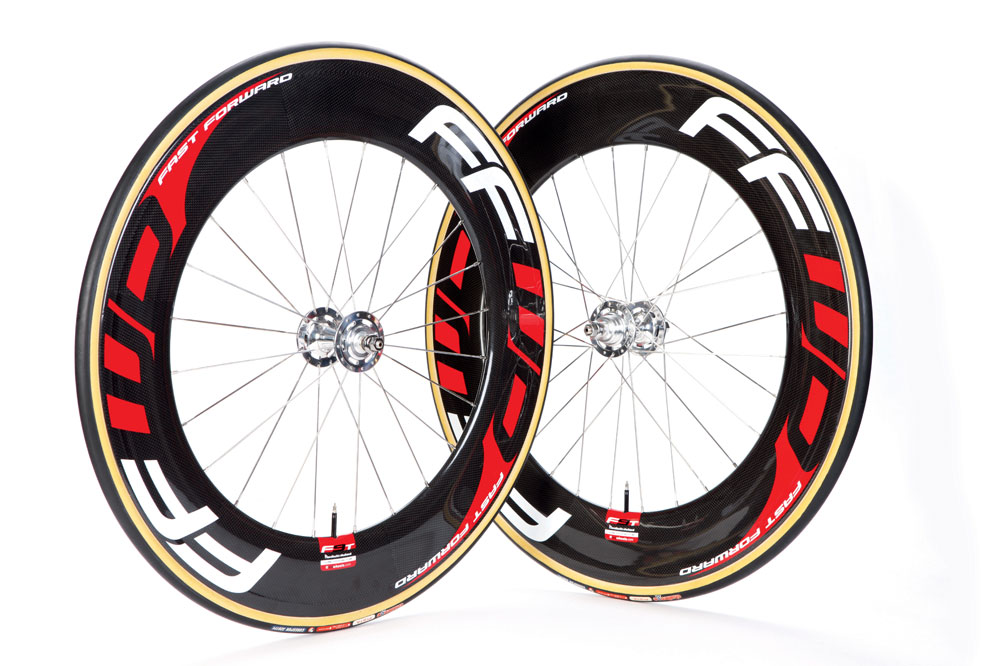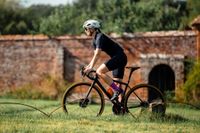Fast Forward F9T track wheels review
Fast Forward hoops are a popular choice on the track, we put a pair of F9Ts though their paces, indoors and out...

A strong and stiff wheel which felt fast when put to the test both indoors and out. A degree of solidness means this is a wheel for racing, less suited to long training sessions - and a 90mm rim is rarely the selection we'd recommend for windy days outdoors.
-
+
Stiff but robust
-
+
Look great
-
-
Avoid use on windy outdoor velodromes
You can trust Cycling Weekly.

As is oft the case, it was a picture (below) that made me realise. It was of myself at the Good Friday track meet, at the front of the bunch (no, I did not stay there longer than absolutely necessary) - and I was the only rider with box section rims. Quelle horreur! It was several nights before I slept properly at the thought of all those lost watts.
Fast Forward's wheels are one of the most popular track choices on the market. Indeed, they're the unanimous brand of choice in the afore mentioned image.
The reason behind their success is a heady blend of performance and value, so of course I had to put them to the test.
Handbuild in the Netherlands, these wheels come with a rim depth of 90mm, and weigh in at 1965g a pair. The width is 22.4mm, and I ran the wheels with 21mm tubs.
There's 24 Sapim CXRay spokes at the front, and 28 at the rear, laced into Fast Forward's own hub. Though a tri-spoke or similar might be faster, this option creates a middle ground which is both resilient and tru-able.
>>> Best bike wheels
One of the greatest struggles for carbon manufacturers is the fine tuning of the characteristics behind stiffness and robustness. A racing wheel needs to be stiff to accelerate well, but go too stiff and the material will be brittle and prone to cracking.
The latest race content, interviews, features, reviews and expert buying guides, direct to your inbox!
To counteract this, Fast Forward has used several different layers of a carbon - a 3k outer weave, with uni directional fibre sheets underneath. Much of the lay up uses High-Tensile TC-35 carbon.
Aerodynamics is crucial too, and to help cut down on the dreaded drag, Fast Forward has used its Double Arc (Darc) tech, which aims to prevent air from 'sticking' to the rim surface by creating a negative arc section, thus compressing more air at the positive section. The result is increased pressure, which makes for faster airflow and less resistance, and thus drag.
Having had some issues fitting wider profile rims into my HOY Fiorenzuola track frame, I was moderately concerned this could be an issue - but the wheel slipped in with ease immediately, though I did have to use my existing skewers and nuts since those supplied were too wide.
That's the 'how' out the way, but what's more important is the effect all of this has on the ride.
We don't have the means to test aerodynamics - but it's undeniable that there's a huge upgrade in acceleration between a box and 90mm rim on the track. Wind cheating effects are greater at higher speed, and they definitely lent a hand on the boards when testing them during race efforts at Lee Valley velodrome.
In a 2014 review of the previous generation, resident trackie and tech editor Symon Lewis raced them at the Spadger six-day and called them "super fast," adding "once rolling, the F9Ts gave a zippy feel, allowing for seemingly effortless pick-up at any speed above 20mph" - and I'd be inclined to wholly agree.
Keen to see if the wheels could withstand outdoor use, I gave them a go at a couple of sessions on Herne Hill's more grippy concrete surface.
In still winds, the wheels still responded well, and I was able to win a few sprints which honestly would have felt out of my reach before.
However, the stiffness of the wheel dramatically hardened the front end feel of my bike, and after a two hour training session (90 minutes of riding) I was feeling more fatigue in my arms and shoulders than normal. This isn't so much a criticism, more an acknowledgement that the wheels are designed for racing, not endurance and training.
In windy conditions, I was forced to swap the front wheel back to a box section. At 58kg, I was fine whilst on a wheel but would waver from the white line as soon as I hit the front. I'd suggest most riders would be best off leaving them at home on a blustery day outdoors.
Michelle Arthurs-Brennan the Editor of Cycling Weekly website. An NCTJ qualified traditional journalist by trade, Michelle began her career working for local newspapers. She's worked within the cycling industry since 2012, and joined the Cycling Weekly team in 2017, having previously been Editor at Total Women's Cycling. Prior to welcoming her first daughter in 2022, Michelle raced on the road, track, and in time trials, and still rides as much as she can - albeit a fair proportion indoors, for now.
Michelle is on maternity leave from April 2025 until spring 2026.
